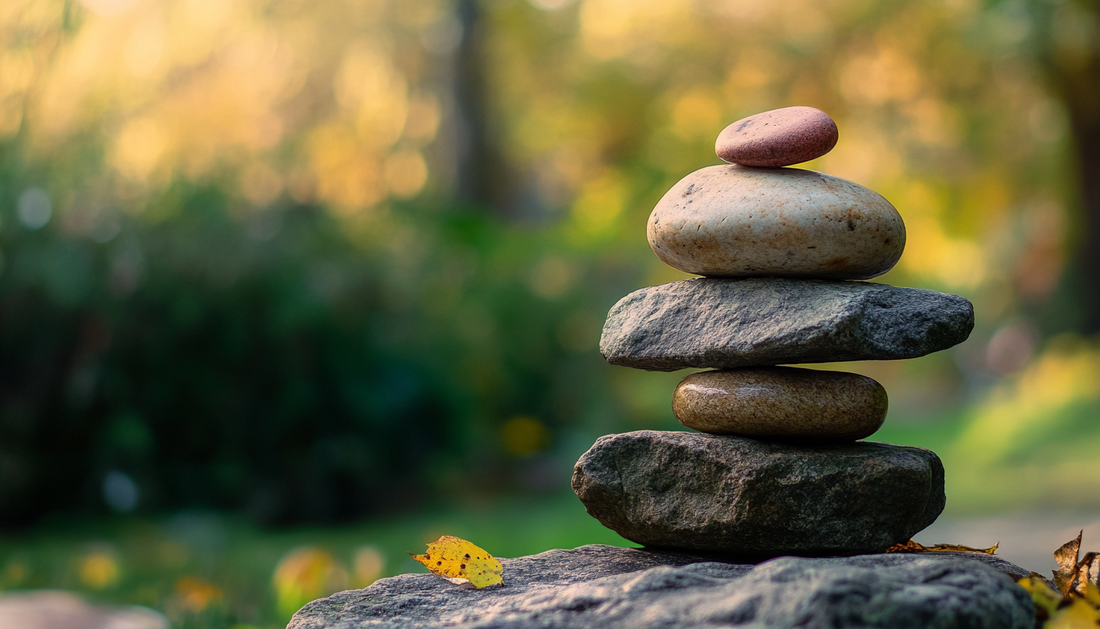
内なる調和: バランスのとれた生活のための自然のサイクルを理解する
共有
人生の自然なリズムを受け入れる
夜明けの静かな瞬間や夜の静寂の中で、私たちのあらゆる動きはリズムによって支配されています。それは時間そのものと同じくらい古いサイクルです。これらの自然のパターンは、気づかれないことが多いですが、私たちの生き方、考え方、呼吸の仕方を形作っています。太陽の昇りから季節の移り変わりまで、これらのサイクルは、調和は私たち自身の内側から始まることを思い出させてくれます。
こうした自然のリズムを受け入れることで、私たちは心の平穏を育み、周囲の世界と調和し、バランスのとれた充実した人生を送ることができます。この旅は、身体、心、そして自然のサイクルの複雑な相互作用を理解することから始まります。

1. 陰と陽のダンス:エネルギーのバランスをとる
中国哲学の中心には、存在の二重の力である陰と陽の概念があります。陰は静かで内省的なエネルギーを表し、陽はダイナミックで外向きのエネルギーを体現しています。このバランスは私たちの日常生活に反映されており、夜(陰)は休息を、昼間(陽)は活動を促します。
しかし、過度な活動や長時間の惰性など、1 つのエネルギーが優勢になると、ストレスや疲労などの不均衡が生じます。休息と活動の両方を尊重することで、身体的および感情的な調和が保たれます。
-
要点:瞑想などの回復のための習慣を取り入れて陽の日々のバランスを取り、陰の安らぎの時期を補うために活動的な活動の時間を作りましょう。

2. 体内時計:体内の24時間時計
睡眠と覚醒のサイクルを司る体内時計である概日リズムは、 エネルギーレベルから認知機能まであらゆるものに影響を及ぼします。不規則なスケジュールや過度の人工光によってこのリズムが乱れると、疲労や健康状態の悪化につながる可能性があります。
アーユルヴェーダでは、この概念はドーシャ(ヴァータ、ピッタ、カパ)と一致しており、それぞれが特定の時間帯に関連付けられています。睡眠、食事、仕事などの日々のルーチンをこれらの自然のサイクルに合わせることで、最適な健康状態が促進されます。
-
プロのヒント:概日リズムを維持するために、就寝前にブルーライトにさらされることを避けてください。休息と活動のための体の自然な合図を尊重してください。

3. 呼吸の力:鼻腔サイクルに合わせる
体は数時間ごとに鼻孔間の空気の流れを交互に繰り返す「鼻サイクル」をご存知ですか?このリズムは、気づかれないことが多いですが、呼吸器の健康と精神のバランスに重要な役割を果たしています。
ヨガでは、プラナヤマ(呼吸のコントロール)がこのリズムを反映しています。ナディ ショーダナ(交互鼻呼吸)などのテクニックは、脳の半球のバランスを整え、ストレスを軽減し、集中力を高めます。
-
実用的なヒント:毎日 5 ~ 10 分間、交互に鼻呼吸をすると、頭がすっきりしてストレスが軽減されます。
-
科学によれば:研究によると、意識的な呼吸は神経系を調整し、血圧を下げ、認知機能を高めるそうです。

4. 月の影響:月が私たちに与える影響
月の満ち欠け(上弦、満月、下弦)は、人間の行動や感情に影響を与えることから、長い間崇拝されてきました。
- 新月:内省と計画の時期。
- 満月: 高まる感情と創造性に関連します。
伝統的な中国医学などの文化では、月のエネルギーは私たちの陰陽のバランスをとると信じられています。月の周期に合わせて行動することで、満月の間に創造性と集中力が高まり、新月の間に休息と内省が促進されます。

5. 季節のサイクルと適応
季節の移り変わりは、私たちの気分、エネルギーレベル、健康に深く影響します。季節ごとに異なる特徴があります。
- 冬:反省と回復を促す(温かくて落ち着く食べ物を強調)。
- 春:再生と成長(浄化と動きに焦点を当てます)。
- 夏:エネルギーと活動を高める(涼しく、水分補給を心がける)。
- 秋:準備と基礎固め(栄養豊富で体を温める食べ物が好まれる)。
アーユルヴェーダや伝統中国医学(TCM)などの伝統的な治療法は、季節の変化に合わせてライフスタイル、食事、活動を適応させ、一年を通してバランスと回復力を確保することを教えてくれます。

6. グローバルな視点:調和のための日々の儀式
世界中の文化では、自然のリズムに合わせた儀式が取り入れられてきました。
- 日本の生きがい: 小さな意味のある習慣を通して目的を見つける。
- スカンジナビアのFriluftsliv:厳しい天候でも屋外での時間を優先する。
- 地中海のライフスタイル:毎日の習慣として愛する人々と食事を分かち合う。
マインドフルな食事や屋外で過ごすなどの習慣を取り入れることで、バランスと喜びの両方を育む儀式を作り出すことができます。

7. シラジットを通して調和を育む
自然のサイクルとの調和を高める、あまり知られていないが強力な方法は、シラジットを使うことです。アーユルヴェーダで崇拝されているこの古代の樹脂には、細胞のエネルギー生成と回復力をサポートするフルボ酸とミネラルが豊富に含まれています。
-
どのように適合するか:シラジットは、陽が優勢な一日の段階でエネルギーを高め、陰が優勢な休息期間中の回復を促進します。
-
推奨事項: 一日を通して持続的なエネルギーと精神的な明晰さを得るために、朝の日課にシラジットを加えてください。
結論: 調和はあなたの手の届くところにあります
調和の本質は、活動と休息、外部からのプレッシャーと内部の平和の間のバランスです。日々、季節、月などの自然のサイクルを受け入れることで、バランスのとれた充実した生活を送ることができます。
真の幸福とは、人生のリズムに逆らうことではなく、それに沿って生きることです。自分の体に耳を傾け、季節を尊重し、調和のとれた習慣を身につけることで、自分自身や周囲の世界とのより深いつながりを築くことができます。



